
The Southeastern Pennsylvania Transportation Authority (SEPTA) is a regional public transportation authority that operates bus, rapid transit, commuter rail, light rail, and electric trolleybus services for nearly 4 million people in five counties in and around Philadelphia, Pennsylvania. It also manages projects that maintain, replace and expand its infrastructure, facilities and vehicles.
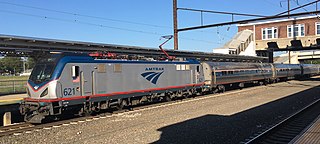
Amtrak's 195-mile (314 km) Keystone Service provides frequent regional passenger train service between the Harrisburg Transportation Center in Harrisburg, Pennsylvania, and 30th Street Station in Philadelphia, running along the Philadelphia to Harrisburg Main Line. Most trains continue along the Northeast Corridor (NEC) to Pennsylvania Station in New York.

The Budd Company was a 20th-century metal fabricator, a major supplier of body components to the automobile industry, and a manufacturer of stainless steel passenger rail cars, airframes, missile and space vehicles, and various defense products.

The SEPTA Regional Rail system is a commuter rail network owned by the Southeastern Pennsylvania Transportation Authority and serving the Philadelphia Metropolitan area. The system has 13 branches and more than 150 active stations in Philadelphia, Pennsylvania, its suburbs and satellite towns and cities. It is the fifth-busiest commuter railroad in the United States, and the busiest outside of the New York and Chicago metropolitan areas. In 2016, the Regional Rail system had an average of 132,000 daily riders and 118,800 daily riders - the last year with reliable data before COVID-19.
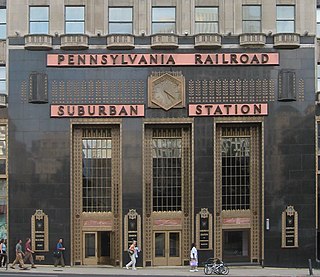
Suburban Station is an art deco office building and underground commuter rail station in Penn Center, Philadelphia. Its official SEPTA address is 16th Street and JFK Boulevard. The station is owned and operated by SEPTA and is one of the three core Center City stations on SEPTA Regional Rail, and is also the busiest station in the Regional Rail network. The station was built by the Pennsylvania Railroad to replace the original Broad Street Station and opened on September 28, 1930.
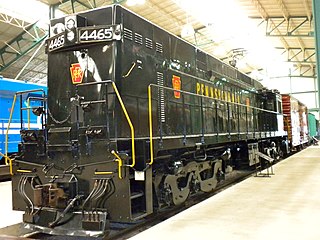
The PRR E44 was an electric, rectifier-equipped locomotive built by General Electric for the Pennsylvania Railroad between 1960 and 1963. The PRR used them for freight service on the Northeast Corridor. They continued in service under Penn Central and Conrail until Conrail abandoned its electric operations in the early 1980s. They were then acquired by Amtrak and NJ Transit, where they lived short lives; all were retired by the mid-1980s. One is preserved at the Railroad Museum of Pennsylvania.
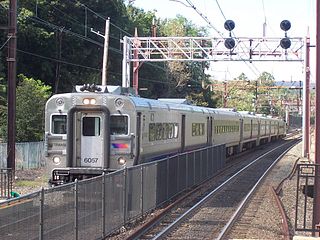
The Comet railcar is a class of locomotive-hauled railcars that was first designed in the late 1960s by Pullman-Standard as a modern commuter car for North American rail lines. Later, the Comet moniker was adopted by NJ Transit for all of its non-powered single level commuter coaches. Additional series of cars bearing the Comet name, based on the original design, have since been built by Bombardier Transportation and Alstom. The successful design was adopted by numerous commuter agencies.

The Pioneer III railcar was a short/medium-distance coach designed and built by the Budd Company in 1956 with an emphasis on weight savings. A single prototype was built, but declines in rail passenger traffic resulted in a lack of orders so Budd re-designed the concept as an electric multiple unit (m.u.). Six of the EMU coach design were purchased by the Pennsylvania Railroad with the intention of using them as a high-speed self-contained coach that could be used for long-distance commuter or short-distance intercity travel in the Northeast U.S. The 6 production Pioneer III units were the first all-stainless-steel-bodied EMU railcar built in North America and, at 90,000 pounds (41,000 kg), the lightest.

The Pennsylvania Railroad's MP54 was a class of electric multiple unit railcars. The class was initially constructed as an unpowered, locomotive hauled coach for suburban operations, but were designed to be rebuilt into self-propelled units as electrification plans were realized. The first of these self-propelled cars were placed in service with the PRR subsidiary Long Island Rail Road with DC propulsion in 1908 and soon spread to the Philadelphia-based network of low frequency AC electrified suburban lines in 1915. Eventually the cars came to be used throughout the railroad's electrified network from Washington, DC to New York City and Harrisburg, PA. The ubiquitous cars became a commuting tradition during their long years of service in several major cities. and were known as "red cars" or "red rattlers". The cars ran in service with the PRR until the Penn Central merger in 1968 at which point they were already being marked for replacement by new technology railcars such as the Budd M1 and Pioneer III. After the bankruptcy of the Penn Central the remaining MP54s found themselves being operated by Conrail under contract with local commuter rail authorities. The last MP54 cars were retired in 1980-81 while engaged in Philadelphia suburban service with SEPTA.

The Budd Metroliner was a class of American electric multiple unit (EMU) railcar designed for first-class, high-speed service between New York City and Washington, D.C. on the Northeast Corridor. They were designed for operation up to 150 mph (240 km/h): what would have been the first high speed rail service in the Western Hemisphere. Although 164 mph (264 km/h) was reached during test runs, track conditions and electrical issues limited top speeds to between 100 mph (160 km/h) and 120 mph (190 km/h) in revenue service. The single-ended units were designed to be arranged in two-car sets, which were in turn coupled into four to eight-car trains.

The Bombardier MultiLevel Coach is a bi-level passenger rail car manufactured by Bombardier for use on commuter rail lines. The first units were delivered in 2006 and deliveries continued to 2014.

The Jersey Arrow is a type of electric multiple unit (EMU) railcar developed for the Pennsylvania Railroad, and used through successive commuter operators in New Jersey, through to NJ Transit. Three models were built, but only the third model is in use today. The series is similar to SEPTA's Silverliner series, but include center doors among other differences in details.

The Media/Wawa Line is a SEPTA Regional Rail service that runs from Center City Philadelphia west to Wawa in Delaware County. It uses the West Chester Branch, which connects with the SEPTA Main Line at 30th Street Station. Under the Pennsylvania Railroad, service continued to West Chester, Pennsylvania. On September 19, 1986, however, service was truncated to Elwyn,.

The Lansdale/Doylestown Line is a SEPTA Regional Rail line connecting Center City Philadelphia to Doylestown in Bucks County, Pennsylvania. Until 1981, diesel-powered trains continued on the Bethlehem Branch from Lansdale to Quakertown, Bethlehem, and Allentown. Restored service has been proposed, but is not planned by SEPTA. The line is currently used by the East Penn Railroad, serving Quakertown's industrial complexes and distribution centers. With around 17,000 daily riders every weekday in 2019, it is the second busiest line in SEPTA's Regional Rail network.
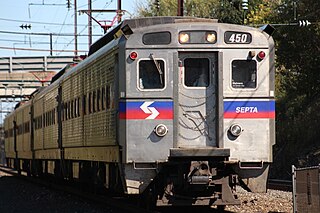
The Paoli/Thorndale Line, or R5 commonly known as the Main Line, is a SEPTA Regional Rail service running from Center City Philadelphia through Montgomery County and Delaware County to Thorndale in Chester County. It operates along the far eastern leg of Amtrak's Philadelphia to Harrisburg Main Line, which in turn was once the Main Line of the Pennsylvania Railroad and is now part of the Keystone Corridor, a federally-designated high-speed rail corridor.

The Silverliner V is an electric multiple unit railcar designed and built by Hyundai Rotem. It is used by Philadelphia's SEPTA Regional Rail and Denver, Colorado's Regional Transportation District. This is the fifth generation railcar in the Silverliner family of single level EMUs.

The ACMUs were a series of electric multiple unit railcars built for the New York Central railroad in three orders between 1950 and 1965. The ACMUs were intended to replace/supplement the original fleet of heavyweight MU cars, some of which dated to the start of electric operations on the New York Central. These were the first New York Central units to offer air conditioning, with sealed windows replacing the drop sash and clerestory types found on earlier cars. The initial set of 100 cars was retired in 1970, upon completion of the M1 railcar delivery, while the second and third orders, totaling 87 cars, remained in service until 2004, when they were replaced by the new M7 fleet.

Silverliner is the name given to a series of electric multiple unit (EMU) railcars in commuter rail service in the Philadelphia area since 1958. As of the introduction of the Silverliner V in 2009–2010, there have been 5 generations of Silverliner cars, identified by the Roman numerals I through V placed after the name Silverliner. The Silverliner name came from the classes' shiny stainless steel body shell, which contrasted with the painted carbon steel railcars used by the Pennsylvania and Reading Railroads between 1915 and 1936. Applied to the first large production order in 1963, the cars made such an impression that the name has since been applied to all subsequent MU classes purchased by SEPTA for the Regional Rail services.
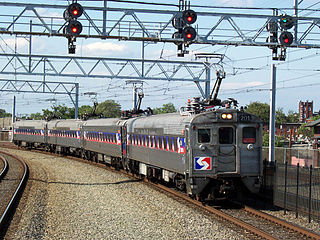
The Budd Silverliner was a model of Electric Multiple Unit railcar designed and built by the Budd Company with 59 examples being delivered starting in 1963. Fifty-five of the cars were purchased for the Reading and Pennsylvania Railroads with public funds for use in Philadelphia, Pennsylvania, area commuter rail service with the remaining 4 cars being purchased by USDOT for use in high-speed rail experiments in 1965. Based on a series of 6 prototype Pioneer III cars built in 1958, the Silverliners represented the first production order of "modern" commuter MU equipment purchased by either railroad and earned their name from their unpainted stainless steel construction which contrasted with the painted carbon steel bodies of the pre-war MU fleets. The cars became a fixture of SEPTA Regional Rail service providing the name to their entire series of EMU railcars before finally being retired in 2012 after 49 years in service.

The Reading electric multiple units were a fleet of electric multiple units operated by the Reading Company on its Philadelphia commuter rail lines. The majority were constructed by Bethlehem Steel in 1931–1933; American Car and Foundry delivered additional cars in 1949. Some cars, rebuilt in 1964–1965 and christened "Blueliners", remained in service with Conrail and later the Southeast Pennsylvania Transportation Authority (SEPTA) until 1990. Several have been preserved.





















